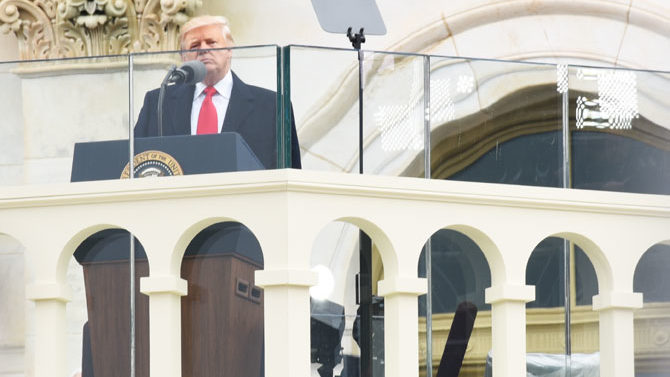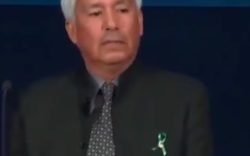The teams of President Trump’s temporary appointees laying the groundwork for taking over and remaking federal agencies refer to themselves as “beachheads” or “beachhead teams,” a military term for the point of invasion.
Politico reports there were approximately 520 members of such teams when Trump took the oath of office. In any presidential transition, there will be tensions between career civil servants and political appointees pushing a new president’s agenda, but according to experts on the matter, this administration’s use of the term may exacerbate those relations.
“The language of war being used suggests that cooperation is not the primary philosophy dictating this transition period,” says professor Heath Brown, who studies presidential transitions at CUNY’s John Jay College of Criminal Justice. “If the operating philosophy is one of combat rather than cooperation, then we’re in for some trouble with how these agencies are going to function on a day-to-day basis.”
Because the Trump team threw out Chris Christie’s transition plans and “started from scratch on Election Day,” Brown says, there is “a larger level of chaos in the past for an already chaotic process.”
Given the fact that Trump was a reality TV star, it is not surprising that communications is the main focus of these beachhead teams. In 2009, Obama only had two communications people on his 13-member senior transition staff. In contrast, at least 10 of 23 staffers in Trump’s transition team served some communications function, Brown says.
In the process, they may well be changing what “communications” means—from informing the public, or even spinning the message, to something more like outright propaganda. Democracy in Crisis uncovered a 1996 Cornell Daily Sun article about then-CNN analyst Kellyanne Conway that shows she has been thinking about media and manipulation for at least 20 years. The story paraphrases Conway (née Fitzpatrick) speaking to student groups about “manipulative media and political jargon.” In the talk, she also criticized people for “following what is decided by a few elite.”
A section of the article subtitled “Questions of Reality” notes: “In a generation where television and internet images ‘bombard our senses,’ it is essential, according to Fitzpatrick, to realize that the [sound bites] or visuals prepared by the evening news editors do not represent reality.”
While this shows that Conway’s obsession with controlling the media narrative is not new, it also underlines how she and her boss are pushing the standard spin of ’90s-era Washington into the full-blown denial of reality in the age of Trump.
During the Trump campaign, fact-checking website Politifact found that only 4 percent of his claims could be considered entirely truthful. Some, including President Obama, naively thought the power of the presidency would curb, rather than increase, Trump’s tendency to lie. But thus far truths remain merely occasional, almost accidental.
After the inauguration on Jan. 20, in the first “unofficial” press conference of the new administration, press secretary Sean Spicer stood in front of reporters and repeatedly lied to the press about things that didn’t matter. It was pointless from any standard political means-ends perspective. (Baltimore City Paper did a great job putting together the actual numbers.)
Later, in his first “official” press conference, Spicer said, “sometimes we can disagree with the facts.”
Between Spicer’s two statements, on the Sunday talk shows, Conway baptized Trump-speak with a succinct name: “alternative facts.” She also threatened to “rethink our relationship” with NBC if “Meet the Press” host Chuck Todd persisted in saying Spicer had lied.
A couple days later, Trump advisor and self-described “Leninist” Stephen Bannon called the press the “opposition party,” which, he said, should “keep its mouth shut.” Almost immediately after this, Trump gave Bannon a spot on the National Security Council.
The attacks on the press, however, are only part of a larger attack on facts themselves—attacks beginning, appropriately, with the communications-obsessed beachheads now inside federal agencies. Trump ordered the EPA to freeze all of its grants, to take down the climate change section of its website (although the administration later backed down on plans to remove content) and to cease all communications with the press.
Then, according to an email obtained by BuzzFeed News, the U.S. Department of Agriculture’s research division prohibited employees, including scientists, from communicating or sharing information with the public. The USDA later lifted the gag order, saying that it was released “without Departmental direction” and was not sent at the request of the Trump administration.
The Trump team also censored the Badlands National Park Twitter feed, deleting tweets mentioning climate change. In response, people claiming to be rangers created a Twitter account for the AltUsNatParkService, which tweeted that it was activated “in a time of war and censorship to ensure fact-based education.”
But information about climate change is not the only thing at risk—data, science and research are being suppressed. And Trump’s congressional allies are all too happy to play along.
Republican Sen. Mike Lee of Utah and Arizona Rep. Paul Gosar introduced bills this week that say “no federal funds may be used to design, build, maintain, utilize or provide access to a federal database of geospatial information on community racial disparities or disparities in access to affordable housing.” This racist bill, which would help maintain segregation in cities, could still die in committee, but it is of a piece with Trump’s all-out war on facts. Deprived of access to facts, citizens are incapable of making decisions. This is an essential feature of tyranny.
As an air of war prevails in Washington, using the term “beachhead” may in fact be among the small minority of things the Trump team is honest about.
Like what you just read? Support Flagpole by making a donation today. Every dollar you give helps fund our ongoing mission to provide Athens with quality, independent journalism.









